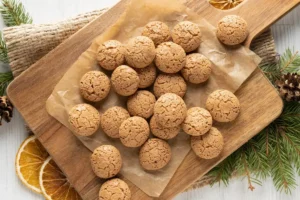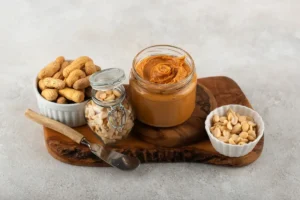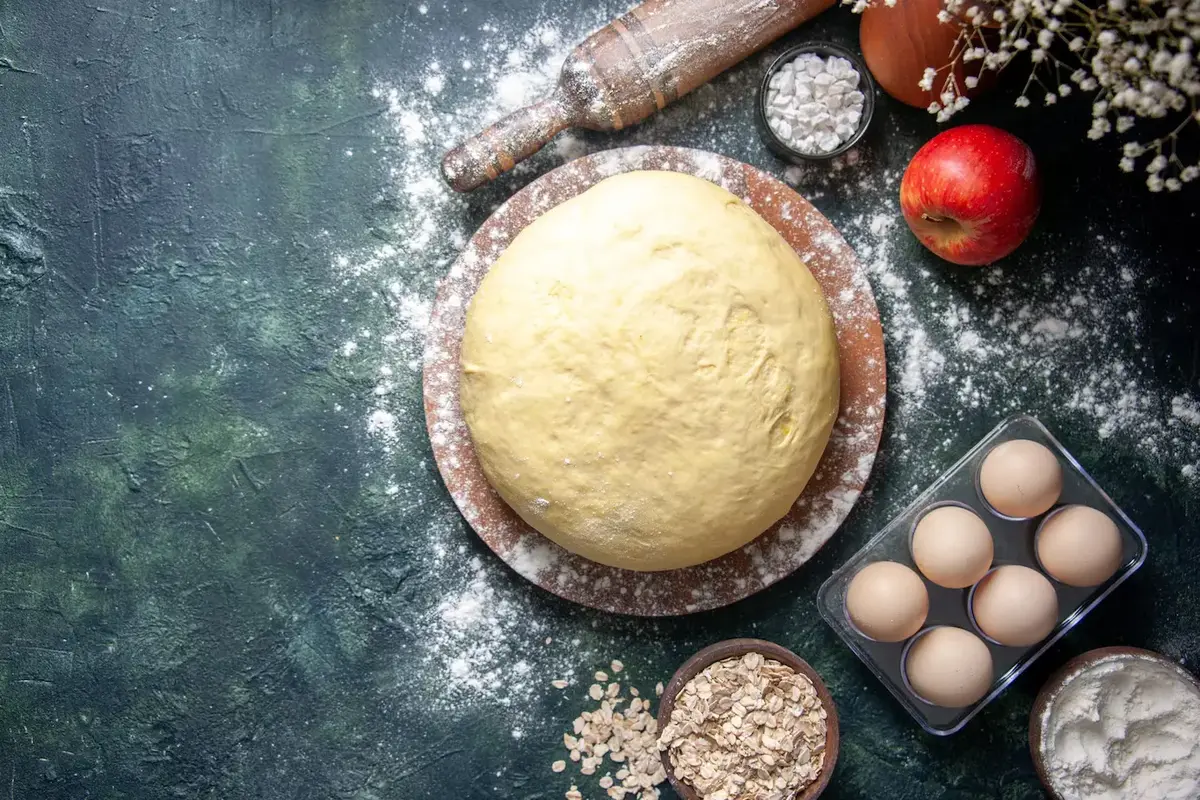Diving into the delightful world of Italian baking, many home chefs and baking enthusiasts often ponder over one crucial question: Can I freeze pignoli dough? This article embarks on a comprehensive journey to unravel the mysteries surrounding the freezing of this cherished dough. With a blend of tradition and practical tips, we aim to guide you through the nuances of preserving the quality and taste of pignoli dough for your baking adventures. Let’s explore the enchanting realm of pignoli cookies, from their rich Italian heritage to modern-day baking techniques, ensuring every reader leaves with a newfound confidence in handling this exquisite dough.
The Charm of Italian Pignoli Cookies

A Sweet Introduction
Ah, pignoli cookies – a name that dances on the tongue as delightfully as the cookies themselves melt in your mouth. These Italian confections have captivated hearts and taste buds around the globe, embodying the essence of Sicilian dessert traditions. But what exactly makes these cookies a staple in the pantheon of Italian sweets?
Originating from the sun-drenched isles of Sicily, pignoli cookies boast a simple yet irresistible blend of almond paste, egg whites, and pine nuts. This trio forms the backbone of a cookie that’s both soft and chewy inside, with a slightly crisp exterior – a textural symphony that’s hard to come by. Imagine biting into a cloud of almond-infused air, grounded by the earthy crunch of pine nuts. It’s no wonder these cookies are a must-have for any festive occasion or a cozy evening at home.
Now, you might be wondering about the role of each ingredient. Well, the almond paste offers a moist and dense foundation, enriched with the sweet, nutty flavors of almonds. Egg whites, on the other hand, act as the binding agent, giving the cookies their light, airy texture. And let’s not forget the pine nuts, whose waxy crunch adds an irresistible contrast to the soft dough.
But here’s the kicker: despite their simplicity, achieving the perfect pignoli cookie is an art form. It all boils down to the quality of your ingredients and how you handle the dough. And with the holiday season ever-looming or that impromptu visit from a friend, knowing whether you can freeze your pignoli dough becomes a game-changer.
So, can you really freeze it? Stick around as we delve deeper into this conundrum, offering you pearls of wisdom that have been passed down through generations of Italian nonnas. Together, we’ll ensure that your pignoli cookies remain a testament to your baking prowess, whether they’re made on the spot or from dough that’s been frozen with care.
Crafting the Perfect Pignoli Cookie

The Freezing Debate

To Freeze or Not to Freeze Pignoli Dough
The dilemma of freezing pignoli dough sparks a debate that tugs at the heartstrings of culinary tradition while nodding to the rhythms of modern life. It’s a decision layered with considerations, from the convenience it offers to the potential impact on those beloved cookies’ texture and flavor.
Embracing Modern Convenience
For the bustling baker, the allure of having pignoli dough ready at a moment’s notice is undeniable. The ability to transform dough from freezer to oven into delectable cookies offers a seamless solution to unexpected guests or spontaneous baking urges. In this light, freezing appears not just as a choice but as a savvy kitchen strategy, ensuring that the warmth of homemade treats can grace any occasion with ease.
Heeding Tradition’s Wisdom
Yet, tradition holds a cautionary tale. The nuanced flavors and distinctive chewiness of pignoli cookies are treasured attributes that aficionados fear may be lost in the freeze-thaw cycle. The richness of the almond paste, in particular, is a cornerstone of the cookie’s identity, prompting questions about whether its integrity can withstand the cold storage.
Finding a Middle Ground
However, hope is not lost for proponents of freezing. The art of preserving pignoli dough‘s essence lies in mastering the freeze-thaw process. By meticulously wrapping the dough to ward off freezer burn and attentively managing the thawing phase, one can safeguard the dough’s moisture and flavor. This approach underscores a harmonious balance between leveraging modern kitchen conveniences and honoring the culinary craftsmanship of traditional baking.
The Art of Freezing and Thawing

Navigating the nuances of freezing pignoli dough requires a blend of scientific understanding and culinary finesse. The objective is clear: maintain the dough’s quality, ensuring that every batch baked from frozen dough rivals its fresh counterpart in both taste and texture.
The Science of Preservation
Wrapping the dough tightly is paramount, protecting it from the arid environment of the freezer. This step is crucial in preventing the dehydration and freezer burn that can compromise the dough’s texture. Furthermore, a slow and gentle thaw in the refrigerator mirrors the dough’s original resting phase, allowing it to awaken from its frozen slumber with its characteristics intact.
The Joy of Baking
Ultimately, whether you choose to freeze your pignoli dough or not, the essence of baking remains unchanged. It’s a process imbued with passion, a celebration of flavors, and a testament to the joy of sharing. Frozen dough or fresh, the true measure of success lies in the smiles that greet each batch of cookies, in the warmth they bring to gatherings, and in the traditions they continue or begin anew.
In this exploration of freezing pignoli dough, we’re reminded of the beauty in blending the old with the new. It’s a testament to the enduring love of baking and the inventive spirit that drives us to adapt and savor life’s sweet moments, one cookie at a time.
Freezing Pignoli Dough Like a Pro
A Comprehensive Guide
The journey to freezing pignoli dough need not be a path strewn with uncertainty. Instead, envision it as a meticulously mapped route to ensuring your beloved cookies are just a preheat away. Here’s how to freeze pignoli dough like a seasoned baker, preserving its essence for that spontaneous moment of indulgence.
Step 1: Portion the Dough
Begin by dividing your pignoli dough into the desired cookie sizes. This not only makes the thawing process more manageable but also ensures uniformity in your cookies. Use a tablespoon or a small ice cream scoop for consistency.
Step 2: Prepare for Freezing
Place the portioned dough balls on a baking sheet lined with parchment paper. Ensure they’re spaced out to prevent them from sticking together. At this juncture, you might opt to roll them in pine nuts, as traditionally done, or leave them bare and roll post-thawing — the choice is yours.
Step 3: Flash Freeze
Transfer the baking sheet to the freezer and flash freeze the dough balls until solid, usually about 2-3 hours. Flash freezing is the secret weapon that combats ice crystal formation, keeping the dough’s texture intact.
Step 4: Store Properly
Once solid, transfer the dough balls into a freezer-safe bag or container. It’s crucial to expel as much air as possible to prevent freezer burn. Label the container with the date, so you know when you embarked on this pignoli adventure.
Step 5: Thaw with Care
When the craving strikes, thaw your dough in the refrigerator overnight. Patience is a virtue that ensures your dough returns to its optimal state, ready to be transformed into golden, nutty delights.
Step 6: Bake to Perfection
Preheat your oven according to your pignoli cookie recipe. Now is the time to roll your dough in pine nuts if you haven’t done so pre-freezing. Place them on a baking sheet, giving them ample space to spread, and bake. Watch as they transform into the beloved cookies, with a slight golden hue and a fragrance that fills your kitchen with warmth.
Following these steps not only bridges the gap between convenience and quality but also pays homage to the traditional essence of pignoli cookies. It’s a testament to the fact that, yes, you can have your cookies and eat them too, anytime the mood strikes.
With the dough safely nestled in the freezer, ready at a moment’s notice, we can now turn our attention to perfecting the art of baking these cookies. From tips that ensure a flawless texture to tricks that bring out the rich almond flavor, let’s ensure your pignoli cookies are nothing short of perfection.
Mastering Pignoli Cookies

Expert Tips for Baking and Freezing
Achieving the quintessential pignoli cookie—crisp on the outside, chewy on the inside, with just the right amount of sweetness—is akin to capturing the essence of Italian baking tradition in every bite. Whether you’re working with freshly made or frozen dough, these expert tips will guide you toward baking perfection.
Tip 1: Quality Ingredients Make the Cookie
The adage “what you put in is what you get out” holds especially true for pignoli cookies. Opt for high-quality almond paste and fresh pine nuts to ensure your cookies have the rich, authentic flavor that makes them so beloved. Remember, the almond paste should be neither too sweet nor too bland, striking that perfect balance that complements the natural sweetness of the pine nuts.
Tip 2: Temperature Matters
If you’re using dough that’s been frozen, allowing it to thaw overnight in the refrigerator before bringing it to room temperature is crucial for even baking. Similarly, ingredients like egg whites should be at room temperature to achieve the desired airy texture in your cookies.
Tip 3: Don’t Overwork the Dough
When mixing your dough, a light touch is key. Overworking the dough can lead to tough cookies due to the development of gluten. Mix just until the ingredients are combined for cookies that are tender and delicate.
Tip 4: The Pine Nut Roll
Rolling your dough in pine nuts before baking not only infuses each cookie with that signature nutty flavor but also adds a delightful crunch. Make sure the nuts adhere well to ensure an even coating that stays put during baking.
Tip 5: Keep an Eye on the Oven
Pignoli cookies can go from perfectly golden to overdone in a matter of minutes. Bake them until they’re just set and lightly golden around the edges. They’ll continue to firm up as they cool, so a slightly underdone appearance is just right.
Tip 6: Storage for Longevity
To keep your pignoli cookies tasting fresh, store them in an airtight container at room temperature. They’ll stay delicious for up to a week, making them perfect for sharing with friends and family—or for savoring a little at a time for yourself.
Tip 7: Embrace Variations
While traditional pignoli cookies are a marvel, don’t be afraid to experiment with flavors. A dash of vanilla extract or a hint of citrus zest can add an intriguing twist to your cookies, making them uniquely yours.
Baking pignoli cookies is more than just following a recipe; it’s an act of love, a tribute to Italian culinary tradition, and a chance to bring a bit of sweetness into the world. Whether you’re preparing them for a special occasion or as a treat for yourself, these tips will help ensure your cookies are nothing short of spectacular.
With the dough mastered and your baking tips in hand, we move forward to the final stages of our pignoli cookie journey.
Thawing and Baking Frozen Pignoli Dough
Thawing and Baking Instructions
The path from frozen dough to warm, inviting pignoli cookies is one filled with anticipation. Each step, from thawing to baking, plays a crucial role in ensuring your cookies emerge from the oven as little masterpieces of Italian baking. Here’s how to seamlessly transition your dough from the cold embrace of the freezer to the warm welcome of the oven.
Thawing with Finesse
Begin the thawing process by transferring your frozen pignoli dough from the freezer to the refrigerator the night before baking. This slow thaw ensures the dough returns to a workable state without any drastic temperature changes that might affect its texture. Once thoroughly thawed, let the dough sit at room temperature for about 30 minutes before baking. This slight warming makes the dough easier to handle, especially if you’re rolling it in pine nuts.
Preheat Your Oven
Preheating your oven is a step that should never be skipped or rushed. For pignoli cookies, an oven temperature of around 325°F (165°C) is ideal. This moderate heat allows the cookies to bake evenly, developing a perfectly golden exterior while maintaining that sought-after chewy interior.
Rolling in Pine Nuts
If you didn’t roll your dough in pine nuts before freezing, now’s the time. Gently press each ball of dough into the pine nuts, ensuring an even coat. This not only adds texture and flavor but also gives the cookies their distinctive appearance. For those who rolled their dough before freezing, you might find a gentle re-roll or a light press into additional pine nuts beneficial, as some nuts may have fallen off during the freezing and thawing process.
Baking to Perfection
Place the dough balls on a parchment-lined baking sheet, allowing enough space for slight spreading. Bake in the preheated oven until the edges are just golden, and the cookies have set. This usually takes about 15 to 20 minutes, but keep a vigilant eye, as ovens can vary. The cookies should look slightly underdone in the center — they’ll continue to firm up as they cool, achieving that perfect chewy texture.
Cooling
Resist the temptation to immediately transfer the cookies from the baking sheet. Let them cool on the sheet for about 10 minutes; this resting period helps set the cookies’ structure. Afterwards, transfer them to a wire rack to cool completely. This step ensures your pignoli cookies don’t become soggy from condensation, preserving their delightful texture.
Enjoying Your Creation
Now, with the baking complete, and the aroma of almond and pine nuts filling the air, your pignoli cookies are ready to be enjoyed. Whether accompanied by a cup of espresso or as a standalone treat, they offer a taste of Italian tradition that’s hard to match.
The journey from frozen dough to exquisite cookies is a testament to the beauty of baking. It’s a process that blends science and art, precision and intuition. By following these steps, you ensure that each pignoli cookie you bake, whether from fresh or frozen dough, is a little piece of perfection.
As we wrap up our guide, remember that baking is more than just following recipes — it’s about bringing joy, sharing traditions, and creating moments that linger in memory long after the last crumb has been savored. Happy baking!
Common Mistakes to Avoid
Pignoli Pitfalls
In the world of baking, even the most experienced bakers can encounter pitfalls, especially when dealing with the delicate nature of pignoli cookies. Recognizing and avoiding these common mistakes can be the difference between achieving baking bliss and facing cookie calamities. Here’s a rundown of potential missteps and how to steer clear of them, ensuring your cookies are always a hit.
Mistake 1: Using Outdated Ingredients
The foundation of a great pignoli cookie lies in the freshness of its ingredients. Using outdated almond paste, stale pine nuts, or old egg whites can significantly impact the flavor and texture of your cookies. Always check the freshness of your ingredients before you begin, ensuring they’re at their peak quality.
Mistake 2: Skipping the Dough Resting Time
Rushing the process by skipping the dough’s resting time is a common oversight. Resting allows the flavors to meld and the dough to achieve the right consistency. If using fresh dough, let it rest at room temperature for a bit before baking. For frozen dough, ensure it’s properly thawed in the refrigerator and then allowed to sit at room temperature, as detailed in Part 6.
Mistake 3: Overworking the Dough
Handling the dough too much can lead to tough cookies. When mixing your ingredients, aim for a light touch. Mix just until the dough comes together to preserve the tender, chewy texture that pignoli cookies are known for.
Mistake 4: Inadequate Pine Nut Coverage
Pine nuts not only add flavor but also contribute to the cookies’ iconic look. An inadequate covering of pine nuts can result in less flavorful cookies with an uneven texture. Ensure each dough ball is well-coated in pine nuts for that perfect bite every time.
Mistake 5: Overbaking
Perhaps the most common mistake is overbaking. Pignoli cookies should be golden around the edges but still soft in the center when removed from the oven. They continue to cook and firm up as they cool, so pulling them out at the right moment is crucial. Keep a close eye on your cookies and start checking a few minutes before the recommended baking time.
Mistake 6: Improper Storage
Storing cookies correctly is essential for maintaining their texture and flavor. Once completely cooled, store your pignoli cookies in an airtight container at room temperature. Avoid stacking them without parchment paper in between if they’re particularly sticky or soft.
Mistake 7: Not Embracing Variations
Finally, a reluctance to experiment with variations can limit your pignoli cookie experience. While traditional recipes are wonderful, adding a personal touch or twist can make your cookies stand out. Whether it’s a dash of citrus zest or a sprinkle of sea salt, don’t be afraid to experiment.
In the grand scheme of baking, these pitfalls are mere stepping stones on your journey to creating the perfect pignoli cookie. By being mindful of these common mistakes and embracing the tips and techniques shared throughout this guide, you’re well on your way to becoming a pignoli cookie connoisseur. So go ahead, preheat that oven, and let the magic of Italian baking fill your kitchen and your heart.

